2014 SUBARU TRIBECA warning
[x] Cancel search: warningPage 39 of 426
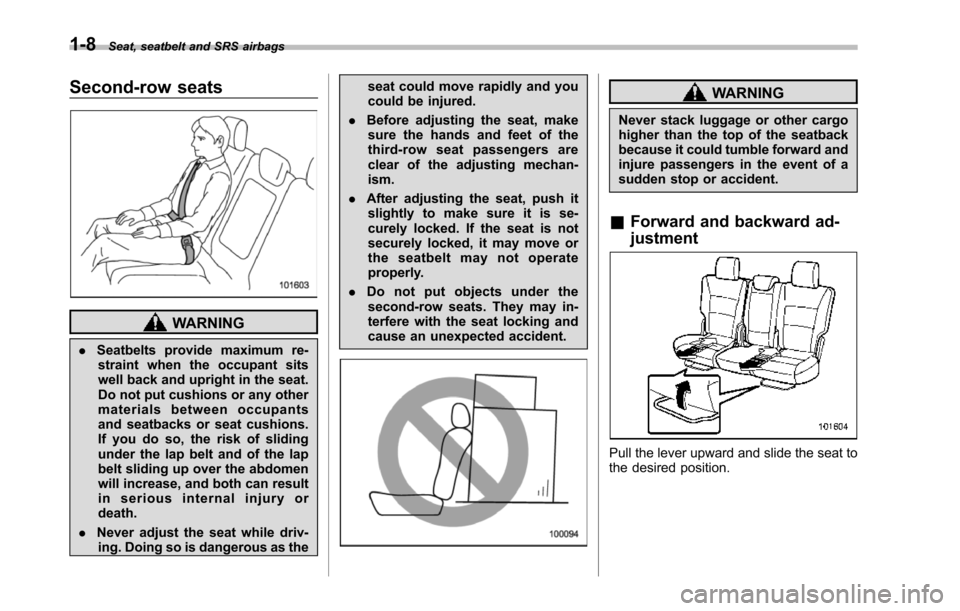
1-8Seat, seatbelt and SRS airbags
Second-row seats
WARNING
.Seatbelts provide maximum re-straint when the occupant sitswell back and upright in the seat.Do not put cushions or any othermaterials between occupantsand seatbacks or seat cushions.If you do so, the risk of slidingunder the lap belt and of the lapbelt sliding up over the abdomenwill increase, and both can resultin serious internal injury ordeath.
.Neveradjust the seat while driv-ing. Doing so is dangerous as the
seat could move rapidly and youcould be injured.
.Before adjusting the seat, makesure the hands and feet of thethird-row seat passengers areclear of the adjusting mechan-ism.
.Afteradjusting the seat, push itslightly to make sure it is se-curely locked. If the seat is notsecurely locked, it may move orthe seatbelt may not operateproperly.
.Do not put objects under thesecond-row seats. They may in-terfere with the seat locking andcause an unexpected accident.
WARNING
Never stack luggage or other cargohigher than the top of the seatbackbecause it could tumble forward andinjure passengers in the event of asudden stop or accident.
&Forward and backward ad-
justment
Pull the lever upward and slide the seat tothe desired position.
Page 40 of 426
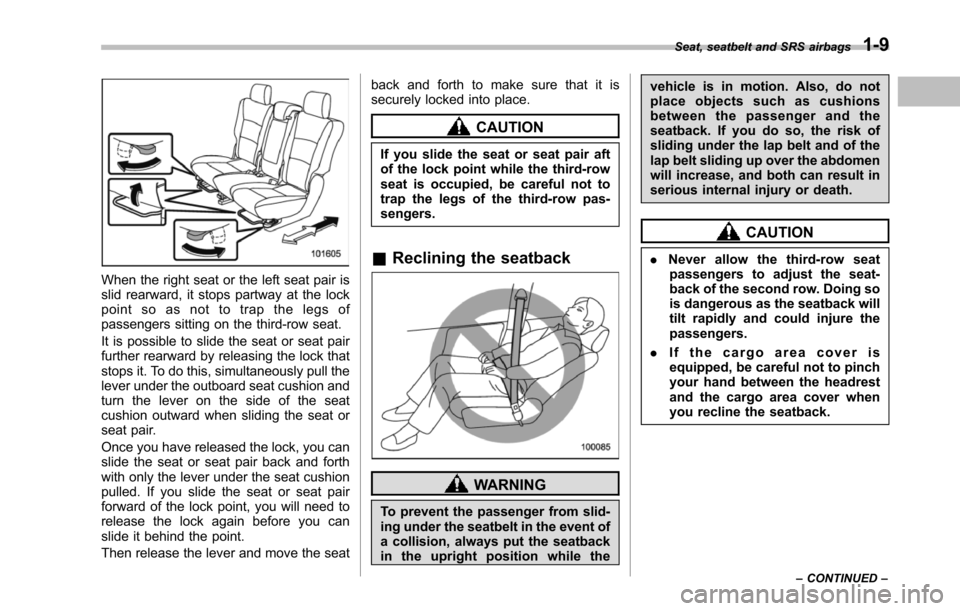
When the right seat or the left seat pair isslid rearward, it stops partway at the lockpoint so as not to trap the legs ofpassengers sitting on the third-row seat.
It is possible to slide the seat or seat pairfurther rearwardby releasing the lock thatstops it. To do this, simultaneously pull thelever under the outboard seat cushion andturn the lever on the side of the seatcushion outward when sliding the seat orseat pair.
Once you have released the lock, you canslide the seat or seat pair back and forthwith only the lever under the seat cushionpulled. If you slide the seat or seat pairforward of the lock point, you will need torelease the lock again before you canslide it behind the point.
Then release the lever and move the seat
back and forth to make sure that it issecurely locked into place.
CAUTION
If you slide the seat or seat pair aftof the lock point while the third-rowseat is occupied, be careful not totrap the legs of the third-row pas-sengers.
&Reclining the seatback
WARNING
To prevent the passenger from slid-ing under the seatbelt in the event ofa collision, always put the seatbackin the upright position while the
vehicle is in motion. Also, do notplace objects such as cushionsbetween the passenger and theseatback. If you do so, the risk ofsliding under the lap belt and of thelap belt sliding up over the abdomenwill increase, and both can result inserious internal injury or death.
CAUTION
.Never allow the third-row seatpassengers to adjust the seat-back of the second row. Doing sois dangerous as the seatback willtilt rapidly and could injure thepassengers.
.If the cargo area cover isequipped, be careful not to pinchyour hand between the headrestand the cargo area cover whenyou recline the seatback.
Seat, seatbelt and SRS airbags1-9
–CONTINUED–
Page 41 of 426
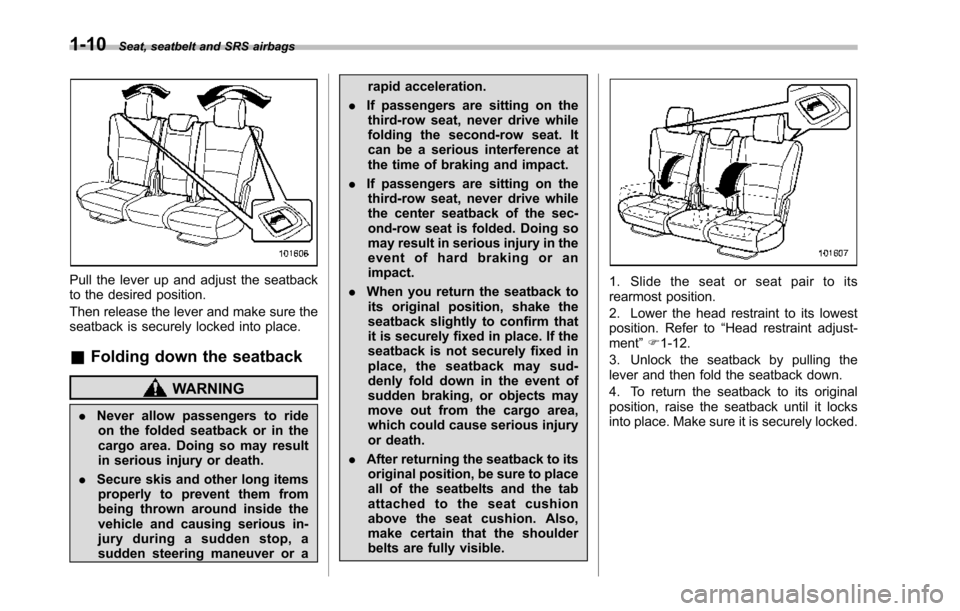
1-10Seat, seatbelt and SRS airbags
Pull the lever up and adjust the seatbackto the desired position.
Then release the lever and make sure theseatback is securely locked into place.
&Folding down the seatback
WARNING
.Never allow passengers to rideon the folded seatback or in thecargo area. Doing so may resultin serious injury or death.
.Secure skis and other long itemsproperly to prevent them frombeing thrown around inside thevehicle and causing serious in-jury during a sudden stop, asudden steering maneuver or a
rapid acceleration.
.If passengers are sitting on thethird-row seat, never drive whilefolding the second-row seat. Itcan be a serious interference atthe time of braking and impact.
.If passengers are sitting on thethird-row seat, never drive whilethe center seatback of the sec-ond-rowseat is folded. Doing somay result in serious injury in theevent of hard braking or animpact.
.When you return the seatback toits original position, shake theseatback slightly to confirm thatit is securely fixed in place. If theseatback is not securely fixed inplace, the seatback may sud-denly fold down in the event ofsudden braking, or objects maymove out from the cargo area,which could cause serious injuryor death.
.After returning the seatback to itsoriginal position, be sure to placeall of the seatbelts and the tabattached to the seat cushionabove the seat cushion. Also,make certain that the shoulderbelts are fully visible.
1. Slide the seat or seat pair to itsrearmost position.
2. Lower the head restraint to its lowestposition. Refer to“Head restraint adjust-ment”F1-12.
3. Unlock the seatback by pulling theleverand then fold the seatback down.
4. To return the seatback to its originalposition, raise the seatback until it locksinto place. Make sure it is securely locked.
Page 43 of 426
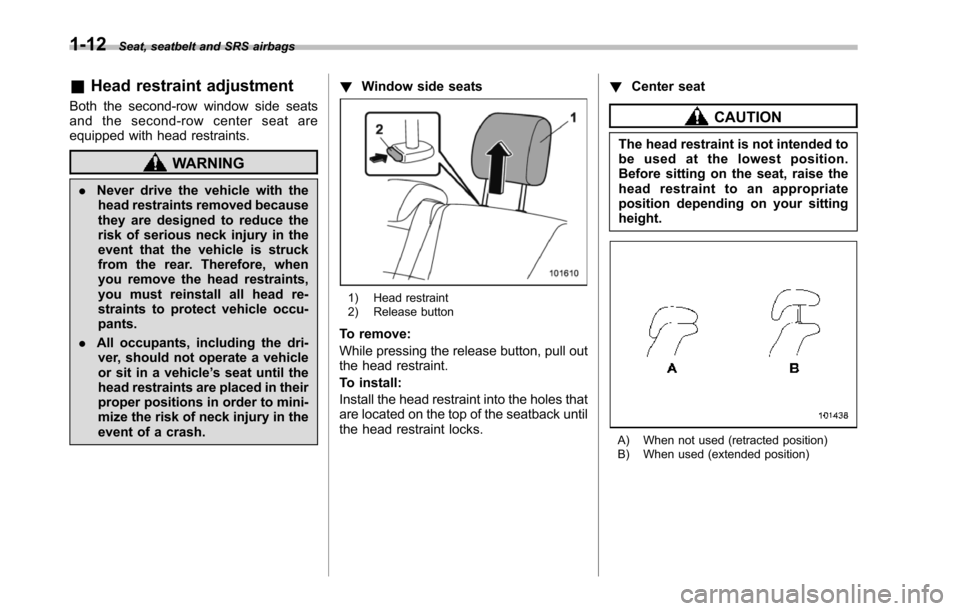
1-12Seat, seatbelt and SRS airbags
&Head restraint adjustment
Both the second-row window side seatsand the second-row center seat areequipped with head restraints.
WARNING
.Never drive the vehicle with thehead restraints removed becausethey are designed to reduce therisk of serious neck injury in theevent that the vehicle is struckfrom the rear. Therefore, whenyou remove the head restraints,you must reinstall all head re-straints to protect vehicle occu-pants.
.All occupants, including the dri-ver, should not operate a vehicleor sit in a vehicle’s seat until thehead restraintsare placed in theirproper positions in order to mini-mize the risk of neck injury in theevent of a crash.
!Window side seats
1) Head restraint2) Release button
To remove:
While pressing the release button, pull outthe head restraint.
To install:
Install the head restraint into the holes thatare located on the top of the seatback untilthe head restraint locks.
!Center seat
CAUTION
The head restraint is not intended tobe used at the lowest position.Before sitting on the seat, raise thehead restraint to an appropriateposition depending on your sittingheight.
A) When not used (retracted position)B) When used (extended position)
Page 44 of 426
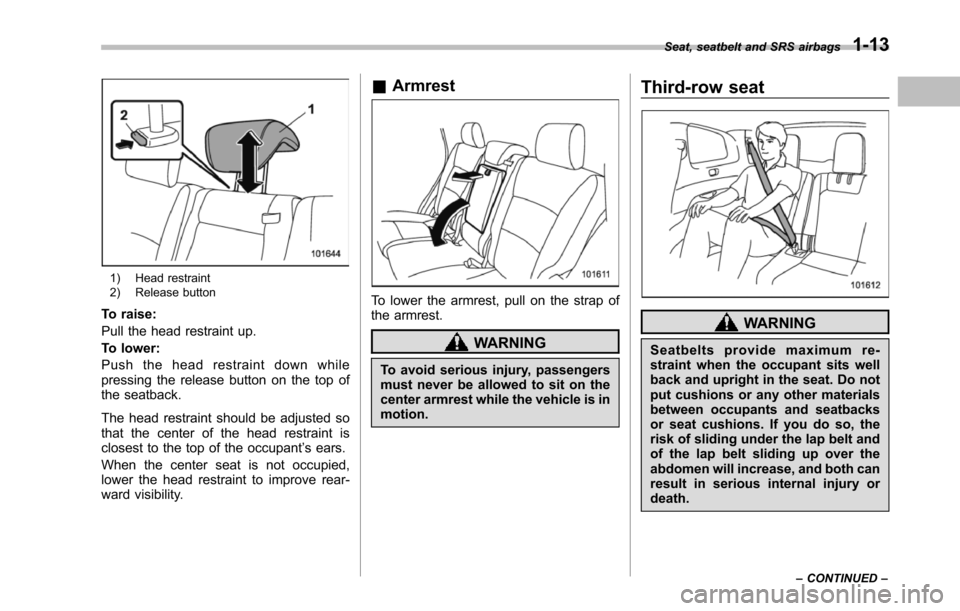
1) Head restraint2) Release button
To raise:
Pull the head restraint up.
To lower:
Push the head restraint down whilepressing the release button on the top ofthe seatback.
The head restraint should be adjusted sothat the center of the head restraint isclosest to the top of the occupant’s ears.
When the center seat is not occupied,lower the head restraint to improve rear-ward visibility.
&Armrest
To lower the armrest, pull on the strap ofthe armrest.
WARNING
To avoid serious injury, passengersmust never be allowed to sit on thecenter armrest while the vehicle is inmotion.
Third-row seat
WARNING
Seatbelts provide maximum re-straint when the occupant sits wellback and upright in the seat. Do notput cushions or any other materialsbetween occupants and seatbacksor seat cushions. If you do so, therisk of sliding under the lap belt andof the lap belt sliding up over theabdomen will increase, and both canresult in serious internal injury ordeath.
Seat, seatbelt and SRS airbags1-13
–CONTINUED–
Page 45 of 426
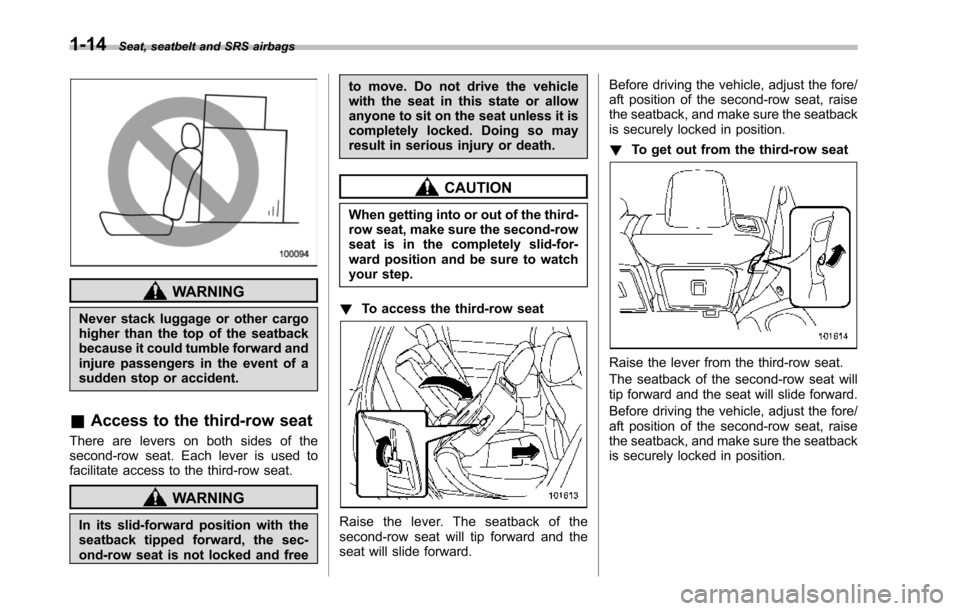
1-14Seat, seatbelt and SRS airbags
WARNING
Never stack luggage or other cargohigher than the top of the seatbackbecause it could tumble forward andinjure passengers in the event of asudden stop or accident.
&Access to the third-row seat
There are levers on both sides of thesecond-row seat. Each lever is used tofacilitate access to the third-row seat.
WARNING
In its slid-forward position with theseatback tipped forward, the sec-ond-row seat is not locked and free
to move. Do not drive the vehiclewith the seat in this state or allowanyone to sit on the seat unless it iscompletely locked. Doing so mayresult in serious injury or death.
CAUTION
When getting into or out of the third-row seat, make sure the second-rowseat is in the completely slid-for-wardposition and be sure to watchyour step.
!To access the third-row seat
Raise the lever. The seatback of thesecond-row seat will tip forward and theseat will slide forward.
Before driving the vehicle, adjust the fore/aft position of the second-row seat, raisethe seatback, and make sure the seatbackis securely locked in position.
!To get out from the third-row seat
Raise the lever from the third-row seat.
The seatback of the second-row seat willtip forward and the seat will slide forward.
Beforedriving the vehicle, adjust the fore/aft position of the second-row seat, raisethe seatback, and make sure the seatbackis securely locked in position.
Page 46 of 426
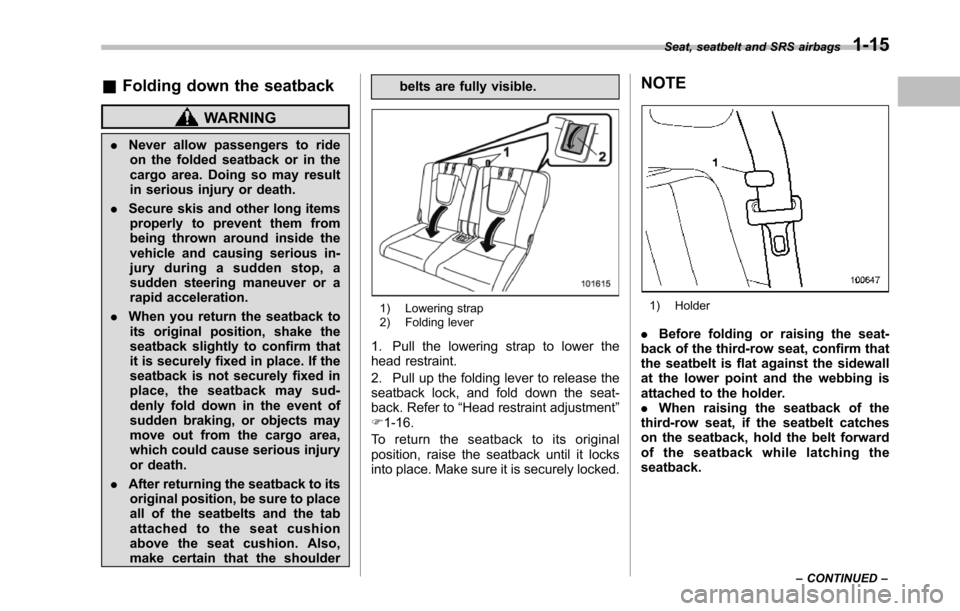
&Folding down the seatback
WARNING
.Never allow passengers to rideon the folded seatback or in thecargo area. Doing so may resultin serious injury or death.
.Secure skis and other long itemsproperly to prevent them frombeing thrown around inside thevehicleand causing serious in-jury during a sudden stop, asudden steering maneuver or arapid acceleration.
.When you returnthe seatback toits original position, shake theseatback slightly to confirm thatit is securely fixed in place. If theseatback is not securely fixed inplace, the seatback may sud-denly fold down in the event ofsudden braking, or objects maymove out from the cargo area,which could cause serious injuryor death.
.Afterreturning the seatback to itsoriginal position, be sure to placeall of the seatbelts and the tabattached to the seat cushionabove the seat cushion. Also,make certain that the shoulder
belts are fully visible.
1) Lowering strap2) Folding lever
1. Pull the lowering strap to lower thehead restraint.
2. Pull up the folding lever to release theseatback lock, and fold down the seat-back. Refer to“Head restraint adjustment”F1-16.
To r e t u r n t h e s e a t b a c k t o i t s o r i g i n a lposition, raise the seatback until it locksinto place. Make sure it is securely locked.
NOTE
1) Holder
.Before folding or raising the seat-back of the third-row seat, confirm thatthe seatbelt is flat against the sidewallat the lower point and the webbing isattached to the holder..When raising the seatback of thethird-row seat, if the seatbelt catcheson the seatback, hold the belt forwardof the seatback while latching theseatback.
Seat, seatbelt and SRS airbags1-15
–CONTINUED–
Page 47 of 426
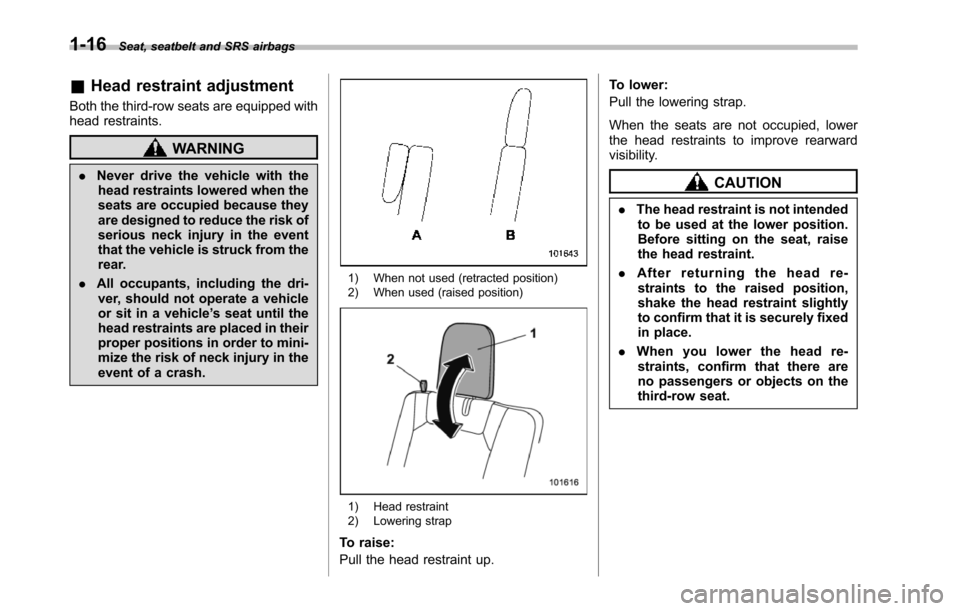
1-16Seat, seatbelt and SRS airbags
&Head restraint adjustment
Both the third-row seats are equipped withhead restraints.
WARNING
.Never drive the vehicle with thehead restraints lowered when theseats are occupied because theyare designed to reduce the risk ofserious neck injury in the eventthat the vehicle is struck from therear.
.All occupants, including the dri-ver, should not operate a vehicleor sit in a vehicle’s seat until thehead restraints are placed in theirproper positions in order to mini-mize the risk of neck injury in theevent of a crash.
1) When not used (retracted position)2) When used (raised position)
1) Head restraint2) Lowering strap
To raise:
Pull the headrestraint up.
To lower:
Pull the lowering strap.
When the seats are not occupied, lowerthe head restraints to improve rearwardvisibility.
CAUTION
.The head restraint is not intendedto be used at the lower position.Before sitting on the seat, raisethe head restraint.
.After returning the head re-straints to the raised position,shake the head restraint slightlyto confirm that it is securely fixedin place.
.When you lower the head re-straints, confirm that there areno passengers or objects on thethird-row seat.